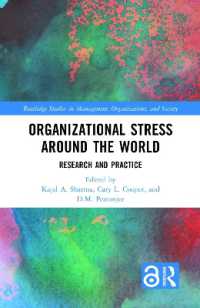- ホーム
- > 洋書
- > 英文書
- > Business / Economics
基本説明
Reviews the motives, goals, strategies and practices of donor agencies and NGOs in North and South, and examines emergency relief and humanitarian assistance as new modes of intervention.
Full Description
This benchmark study by two leading authorities on international development cooperation argues that taxpayer-financed aid remains the best mechanism for promoting greater equality between North and South and within the countries of the South.
Therefore it should be continued while at the same time being made more effective and efficient, and the authors present ideas to achieve this. They conclude by examining new modes of financing development and new modes of international cooperation aimed at bringing about growth and human development.
This major study - replete with detailed statistical and factual information, comprehensive in scope, and penetrating in its analysis - is likely to stand as the authoritative account of international aid for many years.
Contents
1. Introduction
2. Motives and Interests
3. Development Goals
4. Aid Strategies
5. Size and Distribution of Foreign Aid
6. Official Bilateral Assistance
7. Multilateral Aid
8. The Role of NGOs in Development Co-operation
9. Actors in Aid Interaction
10. Emergency Relief and Humanitarian Assistance
11. Evaluation
12. The Impact of Aid
13. Problems and Challenges in Development
14. Perspectives and Prospects for Development Co-operation in the 21st Century








